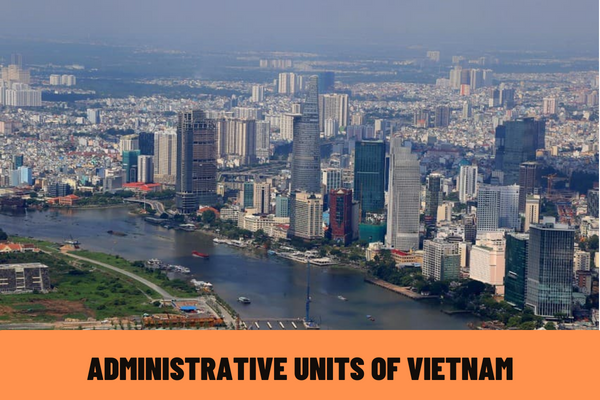How is the current administrative unit classified? What are the criteria for classification for commune-level administrative units of Vietnam?
What are the current administrative units of Vietnam?
According to the provisions of Article 2 of the 2015 Law on Organizing the Local Government of Vietnam as follows:
Administrative units of Vietnam
Administrative units of the Socialist Republic of Vietnam shall include:
1. Municipalities and provinces (hereinafter referred to as province or provincial level);
2. Suburban, urban districts and provincial cities, and municipality-controlled cities (hereinafter referred to as district or district level);
3. Communes, wards or commune-level towns (hereinafter referred to as commune or communal level);
4. Special administrative – economic units.
Thus, administrative units of the Socialist Republic of Vietnam include:
- Municipalities and provinces (hereinafter referred to as province or provincial level);
- Suburban, urban districts and provincial cities, and municipality-controlled cities (hereinafter referred to as district or district level);
- Communes, wards or commune-level towns (hereinafter referred to as commune or communal level);
- Special administrative – economic units.
How is the classification of administrative units of Vietnam regulated?
The classification of administrative units is prescribed in Article 3 of the 2015 Law on Organizing the Local Government of Vietnam as follows:
Classification of administrative units
1. Classification of administrative units serves as a basis for drawing up socio-economic developmental plans and strategies; establishing the mechanism, system and policies for officials and public servants working at local governments in conformity with each type of administrative unit.
2. Classification of administrative units should be based on criteria such as population scale, natural area, the number of affiliated administrative units, socio-economic development level and particular elements of each administrative unit at rural, urban areas and islands.
3. Administrative units shall be classified as follows:
a) Hanoi and Ho Chi Minh City are special-grade province-level administrative units; the rest of administrative units shall be categorized into three grades: grade I, grade II and grade III;
b) District-level administrative units shall be categorized into three grades: grade I, grade II and grade III;
c) Commune-level administrative units shall be categorized into three grades: grade I, grade II and grade III.
4. Pursuant to regulations laid down in Clause 2 and Clause 3 of this Article, the Government shall suggest specific provisions on standards of each criterion, delegated authority and procedure concerning classification of administrative units to the Standing committee of the National Assembly.
Thus, administrative units are classified as follows:
- Hanoi and Ho Chi Minh City are special-grade province-level administrative units; the rest of administrative units shall be categorized into three grades: grade I, grade II and grade III;
- District-level administrative units shall be categorized into three grades: grade I, grade II and grade III;
- Commune-level administrative units shall be categorized into three grades: grade I, grade II and grade III.

How is the current administrative unit classified? What are the criteria for classification for commune-level administrative units of Vietnam?
What are the criteria for classification for commune-level administrative units of Vietnam?
Article 14 of Resolution No. 1211/2016/UBTVQH13 stipulates the criteria for classification of commune-level administrative units as follows:
- Scope of population:
+ Communes with 3,500 people or less are counted 10 points; over 3,500 people, for every 100 additional people, 0.5 points will be added, but not more than 35 points;
+ Mountainous and highland communes shall apply the rate of 75% specified at Point a of this Clause;
+ Communes with national borders on land shall apply the 30% rate specified at Point a of this Clause.
- A natural area of 10 km2 or less is counted as 10 points; over 10 km2, every 0.5 km2 added 0.5 points will be added, but not more than 30 points.
- Level of socio-economic development:
+ Self-balancing local budget revenues and expenditures will be scored 10 points.
If the local budget revenues and expenditures are not balanced by themselves, if the local budget revenues are entitled according to decentralization compared to the total expenditures for the local budget balance of 30% or less, 3 points will be calculated; over 30%, for every 5% extra, 0.5 points will be added, but not more than 8 points;
+ Communes that are recognized as meeting rural standards will be counted 20 points.
In case the commune has not yet met the new rural standard, if it achieves any of the criteria in the system of criteria specified in the new rural standard, each criterion will be counted 1 point, but the total score of the criteria must not exceed 15 points;
+ Communes with national borders on land shall apply the 30% rate specified at Points a and b of this Clause.
- Special elements:
+ From 20% to 30% of the population are ethnic minorities, 1 point is counted; over 30%, for every 5% extra, 0.25 points will be added, but not more than 2 points;
+ Communes with special difficulties are counted 1 point;
+ Zone safety communes are counted 1 point;
+ Having a special national relic or a UNESCO-recognized heritage is counted as 1 point.
LawNet